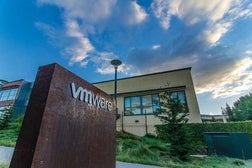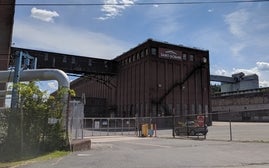Flash data storage: Companies find savings, EMC finds sales
When Peter Carlson started as chief technology officer at the Doctor Franklin Perkins School in Lancaster in September 2012, data storage operations were in disarray.
Information sat across several disparate hard drive-powered systems with independent, non-unified storage functions. Server boot-ups took several minutes, Carlson said, and the system experienced lots of latency — or delays in responding to user requests — when some 400 teachers and students would log in within a 15-minute period each morning.
But everything changed the following June, when Perkins migrated to a storage rack that was part hard drive and part flash, a fast but expensive form of solid-state memory. The hybrid array from Hopkinton-based EMC automatically shifts functions in high demand — such as new emails, databases and document imaging — to the flash, Carlson said, while keeping less-popular items, such as file and photo application servers or years-old emails and documents, on the slower disk-based hard drive.
The improvement in performance has been remarkable, Carlson said. Server boot-ups take just seconds, he said, and students can now save large quantities of data-intensive, high-definition video to the server without causing a slowdown.
The Perkins school is one of many organizations switching from disc to hybrid or all-flash arrays.
Hybrid arrays comprised 21 percent of the external storage system market in 2012 and generated $5.5 billion in revenue, while all-flash arrays made up 1 percent of the market with $260 million in revenue, according to Framingham-based technology research firm IDC.
And the market shares for both are expected to grow. IDC said the market for all-flash arrays is expected to reach 5 percent, or $1.6 billion, in 2016; and hybrid arrays will more than double, to 45 percent, or $14.3 billion, in 2017.
“At some point, flash will kill the traditional hard drive,” said Nathan Boucher, vice president of IT services at Auburn-based Akuity Technologies (Disclosure: the Worcester Business Journal is an Akuity client).
Why is it catching on so quickly?
First and foremost is the need for speed.
Flash can boost response times for both applications and access to data, something the industry has struggled with in recent years, said Jeff Janukowicz, an IDC research director.
From health care to financial services, companies face more pressure to instantaneously analyze data that just got created, said Jayson Noland, an analyst with investment firm Robert W. Baird & Co., which tracks EMC and the tech sector.
The reliability of flash in its early years was suspect, Boucher said, with frequent device failures and pervasive concerns about how much writing could be done to a flash array before it dies. But those fears have dissipated over the past three years, he said.
“Flash, in general, is 10 times as expensive as disk … but offers 100 times the performance,” Noland said.
Companies can often recoup much of their initial investment in flash due to a proliferation of data, which has grown by at least 20 percent annually at places such as the Perkins school due to HD video (which consumes 4 gigabytes of data for every hour of footage) and a buildup of documents in the server's management system, Carlson said.
Hard-drive storage racks run out of space pretty quickly, Carlson said, meaning organizations might have to buy more incompatible disk arrays as data mounts. But fairly large quantities of flash storage can be added to a server without having to purchase a new array, he said.
The smaller physical footprint occupied by flash storage devices means lower costs for physical rack space, electricity and cooling, said Brad Maltz, a virtualization expert at Lumenate, a technology consultancy with operations in Marlborough.
All-flash arrays are starting to offer not only performance but also features such as deduplication, Maltz said. That debuted as part of EMC's first all-flash array, the XtremIO, introduced in September 2013.
Deduplication helps alleviate space constraints associated with expensive flash and can result in eight megabytes of virtual desktop data taking up just one megabyte of array space, said Maltz, whose company assisted EMC with beta testing and market messaging for the XtremIO.
“You don't have to purchase as much storage to store the same amount of data,” he said.
Experts: EMC handling challenges
The rise of flash has posed challenges to established data storage providers such as EMC, though experts generally feel the company has responded well.
“Any time you have an architectural change like that, it opens up a door for smaller companies to come in and take market space,” Noland said.
EMC fended off competition deftly in the hybrid arena by being first to market with a product in 2008, Daniel Cobb, a distinguished engineer and flash evangelist at the company, wrote in an email.
But EMC was a latecomer to the all-flash game, entering the arena in May 2012 by acquiring Israel-based XtremIO, which was still working on its first all-flash product.
“If not the innovator, EMC has proven to be a fast follower,” Noland said.
EMC will continue to invest at least 11 percent of revenue into research and development and 10 percent into mergers and acquisitions to stay ahead of the curve, according to Cobb.













0 Comments